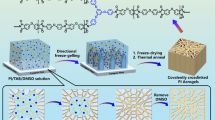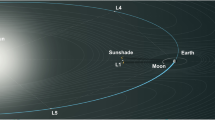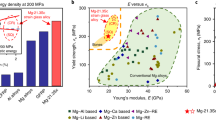Abstract
The quest to develop materials that enable the manufacture of dimensionally ultra-stable structures for critical-dimension components in spacecraft has led to much research over many decades and the evolution of carbon fibre reinforced polymer materials. This has resulted in structural designs that feature a near-zero coefficient of thermal expansion. However, the dimensional instabilities that result from moisture ingression and release remain the fundamental vulnerability of the matrix, which restricts many applications. Here, we address this challenge by developing a space-qualifiable physical surface barrier that blends within the mechanical properties of the composite, thus becoming part of the composite itself. The resulting enhanced composite features mechanical integrity and a strength that is superior to the underlying composite, while remaining impervious to moisture and outgassing. We demonstrate production capability for a model-sized component for the Sentinel-5 mission and demonstrate such capability for future European Space Agency (ESA) and National Aeronautics and Space Administration (NASA) programmes such as Copernicus Extension, Earth Explorer and Science Cosmic Visions.
This is a preview of subscription content, access via your institution
Access options
Access Nature and 54 other Nature Portfolio journals
Get Nature+, our best-value online-access subscription
$29.99 / 30 days
cancel any time
Subscribe to this journal
Receive 12 print issues and online access
$259.00 per year
only $21.58 per issue
Buy this article
- Purchase on Springer Link
- Instant access to full article PDF
Prices may be subject to local taxes which are calculated during checkout





Similar content being viewed by others
Data availability
The data that support the findings of this study are available in Figshare with the identifier https://doi.org/10.15126/surreydata.c.4609958.
Change history
13 January 2020
A Correction to this paper has been published: https://doi.org/10.1038/s41563-020-0609-8
11 February 2020
A Correction to this paper has been published: https://doi.org/10.1038/s41563-020-0617-8
References
Ghidini, T. Materials for space exploration and settlement. Nat. Mater. 17, 846–850 (2018).
Rudolph, H. Some aspects of the future course of polymer research in industry. Polymer J. 17, 13–27 (1985).
Butler, D. Earth observation enters next phase. Nat. News 508, 160 (2014).
Reichhardt, T. NASA roadmap charts route to a quarter-century of exploration. Nature 420, 593–594 (2002).
Sanderson, K. Astronomers unveil wish list. Nature 456, 427–428 (2008).
Gondoin, P. Astronomical opportunities. Nat. Photon. 1, 605–607 (2007).
Battersby, C. et al. The origins space telescope. Nat. Astronomy 2, 596–599 (2018).
Growing pains. Nat. Astron. 2, 691 (2018).
Gibney, E. X-rays top space agenda. Nat. News 503, 7474 (2013).
Burnol, A. et al. Wavelet-based analysis of ground deformation coupling satellite acquisitions (Sentinel-1, SMOS) and data from shallow and deep wells in southwestern France. Sci. Rep. 9, 8812 (2019).
Raspini, F. et al. Continuous, semi-automatic monitoring of ground deformation using Sentinel-1 satellites. Sci. Rep. 8, 7253 (2018).
Pędrak, P., Drajewicz, M., Dychtoń, K. & Nowotnik, A. Microstructure and thermal characteristics of SiC–Al2O3–Ni composite for high-temperature application. J. Therm. Anal. Calorim. 125, 1353–1356 (2016).
Bougoin, M. & Lavenac, J. Large and highly stable structures made of SiC. In Proceedings of the 12th European Conference on Spacecraft Structures, Materials & Environmental Testing 691, 49–56 (ESA/ESTEC, 2012).
Dong, C., Li, K., Jiang, Y., Arola, D. & Zhang, D. Evaluation of thermal expansion coefficient of carbon fiber reinforced composites using electronic speckle interferometry. Opt. Express 26, 531–543 (2018).
Utsunomiya, S. & Shimizu, R. Monitoring of dimensional stability of CFRP mirrors for space telescopes by using embedded FBG sensors. In Proceedings of the 17th International Conference on Composite Materials (2009).
Jang, J. U., Park, H. C., Lee, H. S., Khil, M. S. & Kim, S. Y. Electrically and thermally conductive carbon fibre fabric reinforced polymer composites based on nanocarbons and an in-situ polymerizable cyclic oligoester. Sci. Rep. 8, 7659 (2018).
Chae, H. G. & Kumar, S. Making strong fibers. Science 319, 908–909 (2008).
Albertsson, A. C. & Hakkarainen, M. Designed to degrade. Science 358, 872–873 (2017).
Fujigaya, T., Saegusa, Y., Momota, S., Uda, N. & Nakashima, N. Interfacial engineering of epoxy/carbon nanotubes using reactive glue for effective reinforcement of the composite. Polymer J. 48, 183 (2016).
Utsunomiya, S., Kamiya, T. & Shimizu, R. Development of CFRP mirrors for space telescopes. In Proceedings of Material Technologies and Applications to Optics, Structures, Components, and Sub-Systems 88370P (International Society for Optics and Photonics, 2013).
Soutis, C. & Turkmen, D. Moisture and temperature effects of the compressive failure of CFRP unidirectional laminates. J. Compos. Mater. 31, 832–849 (1997).
Shen, C. H. & Springer, G. S. Moisture absorption and desorption of composite materials. J. Compos. Mater. 10, 2–20 (1976).
Trigo, J. Dimensional stability characterisation of carbon fiber with epoxy and cyanate ester resin laminates due to moisture absorption. Proceedings of the European Conference on Spacecraft Structures, Materials & Environmental Testing 371 (ESA/ESTEC, 1996).
Sharma, H. N., Harley, S. J., Sun, Y. & Glascoe, E. A. Dynamic triple-mode sorption and outgassing in materials. Sci. Rep. 7, 2942 (2017).
Brown, A. et al. Physical origin of early failure for contaminated optics. Sci. Rep. 9, 635 (2019).
Brown, A., Ogloza, A., Taylor, L., Thomas, J. & Talghader, J. Continuous-wave laser damage and conditioning of particle contaminated optics. Appl. Opt. 54, 5216–5222 (2015).
Curcio, J. A. Adsorption and Condensation of Water on Mirror and Lens Surfaces (Naval Research Lab, 1976).
Tveekrem, J. Contamination Effects on EUV Optics (National Aeronautics and Space Administration, 1999).
Bajt, S. in EUV Lithography (ed. Bakshi, V.) Ch. 6A (SPIE Press, 2008).
Scialdone, J. Optimization of outgassing bake-out temperatures and duration of space systems. J. Environ. Sci. 29, 38–40 (1986).
ECSS‐E‐HB‐32‐20 Part 3A Structural Materials Handbook – Part 3: Load transfer and design of joints and design of structures (ECSS, 2011).
Collings, T. & Stone, D. Hygrothermal effects in CFRP laminates: strains induced by temperature and moisture. Composites 16, 307–316 (1985).
Affi, J., OkazakiH., YamadaM. & FukumotoM. Fabrication of aluminum coating onto CFRP substrate by cold spray. Mater. Trans. 52, 1759–1763 (2011).
Silva, S. R. P., Carey, J. D., Khan, R. U. A., Anguita, J. V. & Gerstner, E. G. in Handbook of Thin Films (ed. Nalwa, H. S.) 403–506 (Academic Press, 2002).
Davis, C. A. et al. Direct observation of compositionally homogeneous a-C:H band gap modulated superlattices. Phys. Rev. Lett. 75, 4258–4261 (1995).
Kim, K., Jung, Y. C., Kim, S. Y., Yang, B. & Kim, J. Adhesion enhancement and damage protection for carbon fiber-reinforced polymer (CFRP) composites via silica particle coating. Compos. A Appl. Sci. Manuf. 109, 105–114 (2018).
Choi, H. et al. Moisture barrier properties of Al2O3 films deposited by remote plasma atomic layer deposition at low temperatures. Jpn J. Appl. Phys. 52, 035502 (2013).
Poenninger, A. & Defoort, B. Determination of the coefficient of moisture expansion (CME). In Proceedings of the 9th International Symposium on Materials in a Space Environment 567–572 (ESA, 2003).
Klapprott, D., Li, H., Wong, R. & Geisendorfer, G. Key Factors of the Peel Ply Surface Preparation Process (Henkel Corporation, 2004).
Anderson, G. et al. The effects of silicone contamination on bond performance of various bond systems. J. Adhes. 86, 1159–1177 (2010).
Bardis, J. D. Effects of Surface Preparation on the Long-term Durability of Adhesively Bonded Composite Joints DOT/FAA/AR-03/53 (US Department of Transportation Federal Aviation Administration, 2003).
Anguita, J. V. et al. Thermal stability of plasma deposited thin films of hydrogenated carbon–nitrogen alloys. J. Appl. Phys. 86, 6276–6281 (1999).
Stute, T., Wulz, G. & Scheulen, D. Recent developments of advanced structures for space optics at Astrium, Germany. In Proceedings of the 48th Annual Meeting on Optical Science and Technology 5179, 292–302 (International Society for Optics and Photonics, 2003).
Verlaan, A. L. et al. LISA telescope assembly optical stability characterization for ESA. In Proceedings of the International Conference on Space Optics 105640K (International Society for Optics and Photonics, 2017).
Acknowledgements
We thank Airbus for financial contributions. We thank EPSRC for contributing to the work via the graphene centre programme EP/L02263X/1 in helping to set up the initial infrastructure. We also thank D. Cox and V. Stolojan for the production of sample cross-sections and electron microscopy, T. Pozegic for help with gravimetric data collection and S. Hinder for the XPS analysis.
Author information
Authors and Affiliations
Contributions
The programme was designed by S.R.P.S. and J.V.A. after discussions with T.S., M.F. and M.D. regarding the requirements that evolved after the individual phases. All authors contributed to various research and testing phases of the project. The manuscript was written by J.V.A., C.T.G.S., M.D. and S.R.P.S. All authors contributed and commented on the paper.
Corresponding author
Ethics declarations
Competing interests
The authors declare no competing interests.
Additional information
Publisher’s note Springer Nature remains neutral with regard to jurisdictional claims in published maps and institutional affiliations.
Extended data
Extended Data Fig. 1 Characterisation of the coefficient of thermal expansion (CTE) for CFRP.
Linear expansion measurements for unidirectional UD0 CFRP and BECFRP (b) and unidirectional UD90 CFRP and BECFRP. (c) Co-efficient of thermal expansion measurements for unidirectional UD0 CFRP and BECFRP (d) and unidirectional UD90 CFRP and BECFRP. CFRP is shown in red, while BECFRP is shown in blue. 20 °C is highlighted in green.
Extended Data Fig. 2 List of results from µ-VCM tests.
The results show the total mass loss (TML) and the total amount of collected volatile condensable material (CVCM) of volatile organic compounds (VOC’s) collected using a plate held at 77K with LN2. Some mass loss associated with the TML is due to water adsorbed onto the outer surface of the sample rather than contaminants trapped in the material. The uncoated CFRP reference sample was baked out at 125 °C for 14 days prior to analysis.
Extended Data Fig. 3 Dynamic Scanning Calorimetry (DSC) graphs.
DSC graphs for CFRP and (b) BECFRP highlighting the change the glass transition temperature (Tg).
Rights and permissions
About this article
Cite this article
Anguita, J.V., Smith, C.T.G., Stute, T. et al. Dimensionally and environmentally ultra-stable polymer composites reinforced with carbon fibres. Nat. Mater. 19, 317–322 (2020). https://doi.org/10.1038/s41563-019-0565-3
Received:
Accepted:
Published:
Issue Date:
DOI: https://doi.org/10.1038/s41563-019-0565-3
This article is cited by
-
Stress Transfer in Polymer Nanocomposites: A Coarse-grained Molecular Dynamics Study
Chemical Research in Chinese Universities (2023)
-
Facile synthesis of atomic oxygen-resistant methyl silicone rubber-coated Kapton film for photovoltaic solar array blanket in low Earth orbit
Journal of Coatings Technology and Research (2022)
-
Coarse-grained Dynamics Simulation in Polymer Systems: from Structures to Material Properties
Chemical Research in Chinese Universities (2022)
-
Cooling system during high-pressure microwave curing based on electromagnetic shielding
The International Journal of Advanced Manufacturing Technology (2021)
-
New advances in fiber-reinforced composite honeycomb materials
Science China Technological Sciences (2020)



